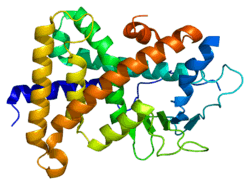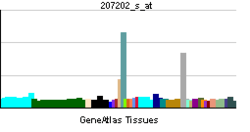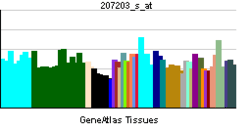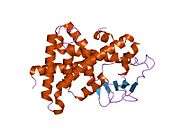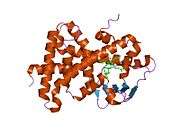Pregnane X receptor
| View/Edit Human | View/Edit Mouse |
In the field of molecular biology, the pregnane X receptor (PXR), also known as the steroid and xenobiotic sensing nuclear receptor (SXR) or nuclear receptor subfamily 1, group I, member 2 (NR1I2) is a protein that in humans is encoded by the NR1I2 (nuclear Receptor subfamily 1, group I, member 2) gene.[4][5][6]
Function
PXR is a nuclear receptor whose primary function is to sense the presence of foreign toxic substances and in response up regulate the expression of proteins involved in the detoxification and clearance of these substances from the body.[7] PXR belongs to the nuclear receptor superfamily, members of which are transcription factors characterized by a ligand-binding domain and a DNA-binding domain. PXR is a transcriptional regulator of the cytochrome P450 gene CYP3A4, binding to the response element of the CYP3A4 promoter as a heterodimer with the 9-cis retinoic acid receptor RXR. It is activated by a range of compounds that induce CYP3A4, including dexamethasone and rifampicin.[6][8]
Ligands
Agonists
PXR is activated by a large number of endogenous and exogenous chemicals including steroids (e.g., progesterone, 17α-hydroxyprogesterone, 17α-hydroxypregnenolone, 5α-dihydroprogesterone, 5β-dihydroprogesterone, allopregnanolone, corticosterone, cyproterone acetate, spironolactone, dexamethasone, mifepristone), antibiotics (e.g., rifampicin, rifaximin), antimycotics, bile acids, hyperforin (a constituent of the herbal antidepressant St. John's Wort), and many herbal and other compounds (e.g., meclizine, paclitaxel).[7]
Antagonists
Ketoconazole is an example of one of the relatively few-known antagonists of the PXR.[9]
Mechanism
Like other type II nuclear receptors, when activated, it forms a heterodimer with the retinoid X receptor, and binds to hormone response elements on DNA which elicits expression of gene products.[7]
One of the primary targets of PXR activation is the induction of CYP3A4, an important phase I oxidative enzyme that is responsible for the metabolism of many drugs.[5][6] In addition, PXR up regulates the expression of phase II conjugating enzymes such as glutathione S-transferase[10] and phase III transport uptake and efflux proteins such as OATP2[11] and MDR1.[12][13]
See also
References
- ↑ "Drugs that physically interact with Nuclear receptor subfamily 1 group I member 2 view/edit references on wikidata".
- ↑ "Human PubMed Reference:".
- ↑ "Mouse PubMed Reference:".
- ↑ Entrez result for NR1I2.
- 1 2 Lehmann JM, McKee DD, Watson MA, Willson TM, Moore JT, Kliewer SA (September 1998). "The human orphan nuclear receptor PXR is activated by compounds that regulate CYP3A4 gene expression and cause drug interactions". J. Clin. Invest. 102 (5): 1016–23. doi:10.1172/JCI3703. PMC 508967
 . PMID 9727070.
. PMID 9727070. - 1 2 3 Bertilsson G, Heidrich J, Svensson K, Asman M, Jendeberg L, Sydow-Bäckman M, Ohlsson R, Postlind H, Blomquist P, Berkenstam A (October 1998). "Identification of a human nuclear receptor defines a new signaling pathway for CYP3A induction". Proc. Natl. Acad. Sci. U.S.A. 95 (21): 12208–13. doi:10.1073/pnas.95.21.12208. PMC 22810
 . PMID 9770465.
. PMID 9770465. - 1 2 3 Kliewer S, Goodwin B, Willson T (2002). "The nuclear pregnane X receptor: a key regulator of xenobiotic metabolism". Endocr. Rev. 23 (5): 687–702. doi:10.1210/er.2001-0038. PMID 12372848.
- ↑ "Entrez Gene: NR1I2 nuclear receptor subfamily 1, group I, member 2".
- ↑ Li H, Dou W, Padikkala E, Mani S (2013). "Reverse yeast two-hybrid system to identify mammalian nuclear receptor residues that interact with ligands and/or antagonists". J Vis Exp (81): e51085. doi:10.3791/51085. PMC 3904218
 . PMID 24300333.
. PMID 24300333. - ↑ Falkner KC, Pinaire JA, Xiao GH, Geoghegan TE, Prough RA (September 2001). "Regulation of the rat glutathione S-transferase A2 gene by glucocorticoids: involvement of both the glucocorticoid and pregnane X receptors". Mol. Pharmacol. 60 (3): 611–9. PMID 11502894.
- ↑ Staudinger JL, Goodwin B, Jones SA, Hawkins-Brown D, MacKenzie KI, LaTour A, Liu Y, Klaassen CD, Brown KK, Reinhard J, Willson TM, Koller BH, Kliewer SA (March 2001). "The nuclear receptor PXR is a lithocholic acid sensor that protects against liver toxicity". Proc. Natl. Acad. Sci. U.S.A. 98 (6): 3369–74. doi:10.1073/pnas.051551698. PMC 30660
 . PMID 11248085.
. PMID 11248085. - ↑ Synold TW, Dussault I, Forman BM (May 2001). "The orphan nuclear receptor SXR coordinately regulates drug metabolism and efflux". Nat. Med. 7 (5): 584–90. doi:10.1038/87912. PMID 11329060.
- ↑ Geick A, Eichelbaum M, Burk O (May 2001). "Nuclear receptor response elements mediate induction of intestinal MDR1 by rifampin". J. Biol. Chem. 276 (18): 14581–7. doi:10.1074/jbc.M010173200. PMID 11297522.
Further reading
- Watkins RE, Noble SM, Redinbo MR (2002). "Structural insights into the promiscuity and function of the human pregnane X receptor.". Current opinion in drug discovery & development. 5 (1): 150–8. PMID 11865669.
- Maruyama K, Sugano S (1994). "Oligo-capping: a simple method to replace the cap structure of eukaryotic mRNAs with oligoribonucleotides.". Gene. 138 (1-2): 171–4. doi:10.1016/0378-1119(94)90802-8. PMID 8125298.
- Suzuki Y, Yoshitomo-Nakagawa K, Maruyama K, et al. (1997). "Construction and characterization of a full length-enriched and a 5'-end-enriched cDNA library.". Gene. 200 (1-2): 149–56. doi:10.1016/S0378-1119(97)00411-3. PMID 9373149.
- Kliewer SA, Moore JT, Wade L, et al. (1998). "An orphan nuclear receptor activated by pregnanes defines a novel steroid signaling pathway.". Cell. 92 (1): 73–82. doi:10.1016/S0092-8674(00)80900-9. PMID 9489701.
- Lehmann JM, McKee DD, Watson MA, et al. (1998). "The human orphan nuclear receptor PXR is activated by compounds that regulate CYP3A4 gene expression and cause drug interactions.". J. Clin. Invest. 102 (5): 1016–23. doi:10.1172/JCI3703. PMC 508967
 . PMID 9727070.
. PMID 9727070. - Bertilsson G, Heidrich J, Svensson K, et al. (1998). "Identification of a human nuclear receptor defines a new signaling pathway for CYP3A induction.". Proc. Natl. Acad. Sci. U.S.A. 95 (21): 12208–13. doi:10.1073/pnas.95.21.12208. PMC 22810
 . PMID 9770465.
. PMID 9770465. - Blumberg B, Sabbagh W, Juguilon H, et al. (1998). "SXR, a novel steroid and xenobiotic-sensing nuclear receptor.". Genes Dev. 12 (20): 3195–205. doi:10.1101/gad.12.20.3195. PMC 317212
 . PMID 9784494.
. PMID 9784494. - Dotzlaw H, Leygue E, Watson P, Murphy LC (1999). "The human orphan receptor PXR messenger RNA is expressed in both normal and neoplastic breast tissue.". Clin. Cancer Res. 5 (8): 2103–7. PMID 10473093.
- Geick A, Eichelbaum M, Burk O (2001). "Nuclear receptor response elements mediate induction of intestinal MDR1 by rifampin.". J. Biol. Chem. 276 (18): 14581–7. doi:10.1074/jbc.M010173200. PMID 11297522.
- Watkins RE, Wisely GB, Moore LB, et al. (2001). "The human nuclear xenobiotic receptor PXR: structural determinants of directed promiscuity.". Science. 292 (5525): 2329–33. doi:10.1126/science.1060762. PMID 11408620.
- Zhang J, Kuehl P, Green ED, et al. (2001). "The human pregnane X receptor: genomic structure and identification and functional characterization of natural allelic variants.". Pharmacogenetics. 11 (7): 555–72. doi:10.1097/00008571-200110000-00003. PMID 11668216.
- Gonzalez MM, Carlberg C (2002). "Cross-repression, a functional consequence of the physical interaction of non-liganded nuclear receptors and POU domain transcription factors.". J. Biol. Chem. 277 (21): 18501–9. doi:10.1074/jbc.M200205200. PMID 11891224.
- Takeshita A, Taguchi M, Koibuchi N, Ozawa Y (2002). "Putative role of the orphan nuclear receptor SXR (steroid and xenobiotic receptor) in the mechanism of CYP3A4 inhibition by xenobiotics.". J. Biol. Chem. 277 (36): 32453–8. doi:10.1074/jbc.M111245200. PMID 12072427.
- Frungieri MB, Weidinger S, Meineke V, et al. (2003). "Proliferative action of mast-cell tryptase is mediated by PAR2, COX2, prostaglandins, and PPARgamma : Possible relevance to human fibrotic disorders.". Proc. Natl. Acad. Sci. U.S.A. 99 (23): 15072–7. doi:10.1073/pnas.232422999. PMC 137545
 . PMID 12397176.
. PMID 12397176. - Fukuen S, Fukuda T, Matsuda H, et al. (2002). "Identification of the novel splicing variants for the hPXR in human livers.". Biochem. Biophys. Res. Commun. 298 (3): 433–8. doi:10.1016/S0006-291X(02)02469-5. PMID 12413960.
- Strausberg RL, Feingold EA, Grouse LH, et al. (2003). "Generation and initial analysis of more than 15,000 full-length human and mouse cDNA sequences.". Proc. Natl. Acad. Sci. U.S.A. 99 (26): 16899–903. doi:10.1073/pnas.242603899. PMC 139241
 . PMID 12477932.
. PMID 12477932. - Chang TK, Bandiera SM, Chen J (2003). "Constitutive androstane receptor and pregnane X receptor gene expression in human liver: interindividual variability and correlation with CYP2B6 mRNA levels.". Drug Metab. Dispos. 31 (1): 7–10. doi:10.1124/dmd.31.1.7. PMID 12485946.
- Dussault I, Yoo HD, Lin M, et al. (2003). "Identification of an endogenous ligand that activates pregnane X receptor-mediated sterol clearance.". Proc. Natl. Acad. Sci. U.S.A. 100 (3): 833–8. doi:10.1073/pnas.0336235100. PMC 298687
 . PMID 12569201.
. PMID 12569201. - Kawana K, Ikuta T, Kobayashi Y, et al. (2003). "Molecular mechanism of nuclear translocation of an orphan nuclear receptor, SXR.". Mol. Pharmacol. 63 (3): 524–31. doi:10.1124/mol.63.3.524. PMID 12606758.
External links
- pregnane X receptor at the US National Library of Medicine Medical Subject Headings (MeSH)
This article incorporates text from the United States National Library of Medicine, which is in the public domain.
Nuclear Receptor Resource Page http://nrresource.org/nr_page_collection/nr1i2-pregnane-x-receptor.html
